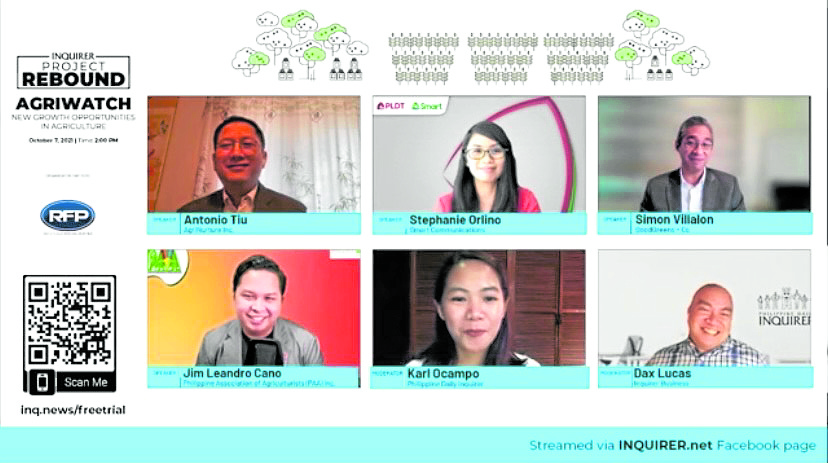Technology may have saved—even boosted—some businesses during the pandemic, but agriculture has yet to make full use of its potential to increase production, reach out directly to markets and buyers and keep abreast of scientific advances.
At the recent Project Rebound webinar, panelists noted that Filipino farmers are already aging and not as open to learning, much less adopting, new technologies. But they also expressed optimism that because the pandemic created major disruptions in almost all sectors of Philippine society, including agriculture, farmers would be more willing to explore new technologies to survive the current crisis and prepare for the next one.
The panelists on the topic “Agriwatch: New Growth Opportunities in Agriculture” also raised the possibility that new technologies might help encourage young people to consider agriculture and related fields as career options.
Jim Leandro Cano of the Philippine Association of Agriculturists (PAA), Inc. said COVID-19 shone the spotlight on “preexisting irregularities” that only got worse. “The digital divide further marginalized many farmers,” he said.
Stephanie Orlino of Smart Communications added, “[Digitalization] is widening the gap in agriculture because farmers are aging and not so open to new technologies.” Many mobile phone applications designed for agriculture had not been adopted so there was a need to provide training in their use, she said.

New technology
What saved farmers from being completely wiped out was the readiness and willingness of different groups to assist.
“People were quick to respond and help,” Simon Villalon of GoodGreens +Co said. Linkages between producers and consumers were established. He stressed, however, that farmers had to learn mass production technologies and infrastructure, like roads and bridges, had to be built to prepare them for future crises.
“A shift to new technology is a must,” said Antonio Tiu of AgriNurture Inc. During the pandemic, they tried connecting with producers through social media but digital inclusion remained a problem, he said. Farmers should also be targeted by financial inclusion campaigns to help them gain access to needed funds.
Cano said introducing farmers to digitalization involved more than just access to hardware and software. They had to acquire digital literacy. He added that disruptions in the supply chain during the pandemic also underscored the need for new farm technologies. But he said, “Technology should revolve around people, not the other way around.”
Orlino said the popularity of Smart’s digital farming programs, started in 2019, surged last year as more people realized the value of technology. The telco is using technological advances to encourage the young to help farmers.
Villalon said his company was promoting urban farming to help fill gaps if food supply disruptions occur in the future. Technologies were available to make urban farming viable.
Private enterprises
Tiu said private enterprises wanted to help alleviate food security problems. Farmers had to be encouraged to work toward greater productivity to reduce dependency on food imports and even increase export of local produce.
Cano said there was a need to identify priorities and how scientists could help farmers add value to their products so they could earn more.
The panelists underscored the need to help farmers climate- or weather-proof their farms. Orlino said timely and accurate information should be provided so farmers could better prepare for disruptions.
Villalon added there was a need to take a long view and look at the big picture to help farmers, especially in disaster-prone areas, prepare and respond better to calamities.
More investments in infrastructure and weather-related technology should be made, according to Tiu. Dissemination of information to farmers should also be improved.
“There is no single solution or silver bullet to solve agricultural problems,” Cano pointed out. While he agreed on the need for climate-proofing, he added technology did not only mean new. “Old, new, even ancient technology” should be considered. Many technologies of the past could still be relevant and useful.
Agri possibilities
The panelists stressed the young should be made aware of the many possibilities in agriculture. “We have to change their mindset,” Tiu said, and make them realize agriculture was not the drudgery depicted in Filipino folk songs. They had to be made aware that agriculture could be profitable if they made the right choices.
Villalon expressed the view that technology and farm mechanization could make the young interested in agriculture. There were many good talents in the country, he said, so Filipino creativity should be tapped to develop farming technologies, instead of using imports. The farmers’ digital literacy should be raised to increase adoption of technology. “There are challenges but also opportunities to create and innovate.”
“People think of agriculture simply as planting. They have to know that there are many possibilities in the supply chain range,” Cano said. An environment had to be created to make young people explore agriculture.
“There are many opportunities in agriculture. We have to try to reinvent it for the sake of our country and the next generation,” Tiu stressed.
Project Rebound was hosted by Inquirer’s Karl Ocampo and Daxim Lucas.








